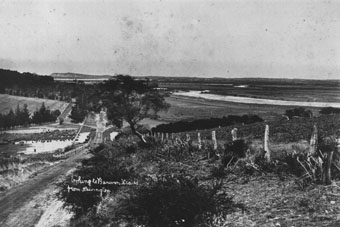An extract from Tourists' Guide to Geelong and the Southern Watering Places, published in 1893.
|
"The district of Newington may be considered as a part of Ocean Grove, being only two miles distant, although in point of history it is much older than the latter.
For postal and telegraphic arrangements Ocean Grove is the most convenient office. The country embracing Newington is very fertile, undulating, and beautiful. It has a neat Wesleyan Church, a perfect model for a country place of worship both internally and externally, and Divine Service is conducted there every Sunday afternoon at 3 o'clock.
There is also a State School, and several well kept farms and orchards. The latter give promise of splendid results, and we should say that no better field presents itself than the slopes and valleys of this district for profitable fruit growing combined with vegetables. It is already famous for melons and pumpkins both as regards size and quality.
The class of settlers are evidently comfortable in their circumstances, and this colony just needs to have a yeoman population satisfied with happy homes, and their surroundings to make it free from the blight of avarice and speculation which has so severely cursed our land.1"
This description of Newington "as part of Ocean Grove" is rather unfair and obviously biased by the heavy Ocean Grove influence in this particular publication. It is ironic that Ocean Grove was "created" in 1887-88 and prior to that all the land included in the Ocean Grove subdivision was called Newington in the Shire of Bellarine rate books! The area described as Newington stretched from the "boundaries" of the Barwon River, Wallington and Marcus Hill, down to Bass Strait.
There has been much debate on the origins of the name Newington. It is worth quoting directly from Brian Kemp's Newington : 125 Years of Christian Witness, published in 1988.
"The name Newington has given rise to long and heated discussions and after a great deal of delving I am still unable to give a definitive explanation as to its origin. It was first thought to have had some connection with the first squatter in the Wallington area, Fairfax Fenwick, but there seems to be no traceable link with him or his ancestral district in England. The first inkling of a connection came from later settlers from the orcharding areas of Somerset and Kent in England when they arrived in this district shortly after Fenwick and established some of the earliest orchards in Australia. There is a village of Newington in Kent. However, the most likely explanation, and the one I tend to favour, is that the name Newington came from the Rev. John Wesley's close association and lifelong friendship with the Rev. John Fletcher. In Wesley's personal journals he often refers to Fletcher and on one occasion he visited him at Newington. Although it is not specific I think the Newington referred to is the Newington Church in Southwark, London and a fairly obvious choice for a new congregation wishing to spread the message of Wesleyan Methodism. Nevertheless there remains some doubt but it is clear from the Wesleyan Methodist Preacher's Plan for the Circuit of Drysdale 1887-8 that the area in the vicinity of the church became known as Newington and was considered to be a different district than that of Wallington as Messrs Thomas and Butler are listed as residing at Newington while Mr. Jennison is listed as residing at Wallington. Later, when there was confusion between Newington in this area and another Newington in the Ballarat area, the area in the vicinity of the church became known as Fenwick and the name Newington referred only to the church, as it does today.2"
The subdivision of Newington was first offered for sale in 1853 - 35 years before the subdivision of Ocean Grove. It boasted both a church and a school which had 50 pupils in 1874. The effect on Newington of the new "town" of Ocean Grove was most obvious in 1891 when the Ocean Grove school open - the Newington school lost more than half its pupils. With only six pupils in 1896 the school was closed and three years later physically moved to Wallington.3
References :
- A. J. Campbell, Tourists' Guide to Geelong and the South Watering Places, Henry Thacker, Geelong, 1893, p. 46.
- Brian Kemp, Newington : 125 Years of Christian Witness 1863 - 1988, 1988, p. 1.
- Ian Wynd, Balla-Wein : A history of the Shire of Bellarine, Shire of Bellarine, Drysdale, 1988, p. 107.
[From the files of the Bellarine Historical Society and the Geelong Historical Records Centre]
Record Sources for Newington
- Photographs : Bellarine Historical Society; Geelong Historical Records Centre; various private collections.
- Maps & Plans : Bellarine Historical Society; Geelong Historical Records Centre.
- Newspapers : Geelong Advertiser Indexes - Bellarine Historical Society & Geelong Historical Records Centre; Geelong Advertiser on microfilm - Geelong Historical Records Centre; various local newspapers - Bellarine Historical Society.
- Miscellaneous Documents & Advertisements : Bellarine Historical Society; Geelong Historical Records Centre; various private collections.
- Bellarine Shire Council Records : Geelong Historical Records Centre.
- More recent Council Records : City of Greater Geelong.
- Cemetery Records : (Leopold/Kensington Cemetery) Bellarine Historical Society; Geelong Historical Records Centre.
- Land Records : Registrar of Titles, Melbourne; Bellarine Historical Society; Geelong Historical Records Centre.
Bibliography
Brownhill, Geo. H. Illustrated Guide to Geelong And District, Facsimile edn., Deakin University Press, Geelong, 1990.
Campbell, A. J. Tourist Guide to Geelong and Southern Watering Places, Henry Thacker, Geelong, 1893.
Brian Kemp, Newington : 125 Years of Christian Witness 1863 - 1988, 1988.
Wynd, Ian. Balla-wein : A history of the Shire of Bellarine, Shire of Bellarine, Drysdale, 1988.
Wynd, Ian. Geelong The Pivot : A Short History of Geelong and District, Cypress Books, Mont Albert North, 1971.

